How to setup a pre-launch landing page for your business idea in 20 minutes Jun 7 2013
This is part three of our series on finding, validating and testing business ideas to launch a new business that not only makes money, but makes you happy too!
Part one: Business? What business?
Part two: Validating business ideas
In the last post, we looked at the best ways to validate your business ideas, to find the best one if you have multiple ideas (or at least to narrow them down), and to ensure that there is an audience or market that could be receptive to what it is that you want to offer. We did that by looking at search results and advertising reach, however it's not as concrete as getting people to actually say they are interested. The next step is to give people a way to do that, so that you can start reaching out to them, and marketing your idea before you've even started it.
Before we start
As it's early days, you might not have a name yet for your business, idea, or product, especially if you're still evaluating a few concepts. However you need something to refer to it by, and so the users that will see your landing page will have a name to call it. This doesn't have to be the final name, and so if you're in doubt about it, just keep it simple, clear, and the most important thing of all - you need a matching domain name to go with it (preferably .com). If a domain isn't available with the initial name you have in mind, remember to add something to the end - "book" for a book, "app" for an app etc. You can then purchase your domain very cheaply from many different online places, however we'd recommend either 1and1, DNSimple, or iwantmyname.
Options
Now we have a domain, let's take a look at the options we have for getting a simple landing page up and running to let people register their interest.
Launchrock
Launchrock, as the name indicates, is mainly geared towards pre-launch pages. It includes a lot of features designed to help incentivize users for sharing the page when registering their interest, and to promote social aspects and integration. It therefore fits nicely with any kind of product that is social in nature, as it sets the right tone in terms of engagement. You can turn these options off if it doesn't fit your business/product, although the more sharing and social options you provide, the more chance you have of an idea "going viral" and being widely circulated.
Unbounce
Unbounce is for building and publishing landing pages, a more general aim also taking into account existing businesses and products that want specific landing pages for ad campaigns, for certain products or offers, or when they're launching something related but new. They also have a keen focus on what's called A/B testing - a type of variant testing that allows you to present two versions of the page to different users, and to see which one performs best. This allows you to make small modifications and test them, with real analytics to look at when deciding whether to make the change for good or not.
Another thing they provide which is very nice is an extensive range of templates for your landing pages, coping with numerous different scenarios, and a lot of different well put together styles. This means you can get up and running with a great looking landing page in not much time at all.
ConvertKit
ConvertKit takes a slightly different focus again. The idea with ConvertKit isn't to immediately try to sell someone a product, or get them to register their interest directly for a product per se, but instead provide an engaging landing page that will allow the user to register their interest in whatever it is you do or offer. It's a bit more about expertise, with the focus on "drip marketing", and allowing you over time to demonstrate what it is you can do with informative, useful emails, so that when you are ready to launch a product or new business idea, you have an audience who is ready to hear about it - and not only that, they already trust you.
Putting it into action
As with our last article, let's run through a concrete example to setup a landing page, and see how it works. Each of the tools we outlined offers something slightly different, and there are numerous other tools and apps that provide similar things. We chose those three to demonstrate the spectrum of aims you might have with a landing page, but now we're putting it into action, let's pick a specific scenario, and follow through how to set it up.
Here is where I also give you a sneak peak at something new we're thinking of building here at KickCode - I'll be putting my money where my mouth is and setting up a landing page myself! The new app is called Stashlog, and is an app to catalogue your entertainment media, from books and CDs, to DVDs and videogames. We'll go into more detail on our ideas for the app in a future post, but for now let's get that landing page up so we can gauge interest in it!
We're going to use Launchrock, because of its focus on landing pages specific to new businesses or products. It's also free, which makes it great for trying out new ideas quickly and easily.
Head over to launchrock.co, and enter your email, then a password to begin. When you first login it'll start a project for you, and ask you to choose between a landing page and an embedded widget. We'll select landing page:

We then need to choose a theme. Pick one that you like the look of, and that suits the idea. You can select them to preview them. We've gone for the mobile app focused theme, as one of the core Stashlog features will be the iOS app:
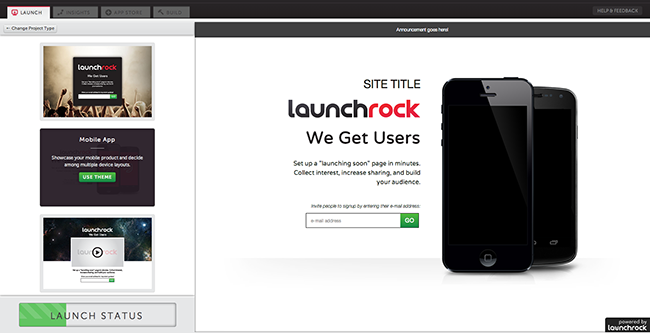
You'll need to select "Use Theme" on your chosen theme, and then you can customise it further with your own text, colours, and images. Don't worry too much about making the text absolutely perfect right now, you can refine it over time. Just make sure it communicates your idea clearly, and proof read it a couple of times to make sure there are no spelling or grammatical errors.

After that, you can customise the sharing options, including the email that will get sent to users by other users if they share to their friends.
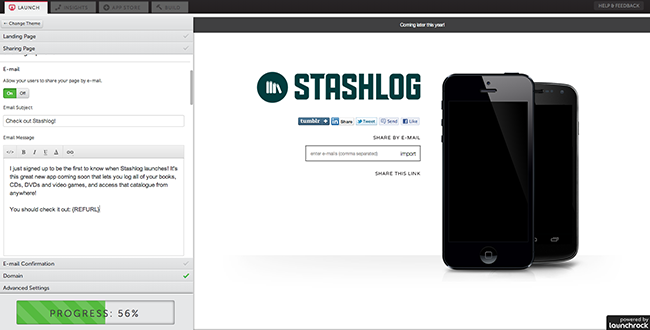
You can then work through all of the social options to point people towards Twitter, Facebook, Instagram accounts etc. Don't worry if you haven't set these up, you can add them later.
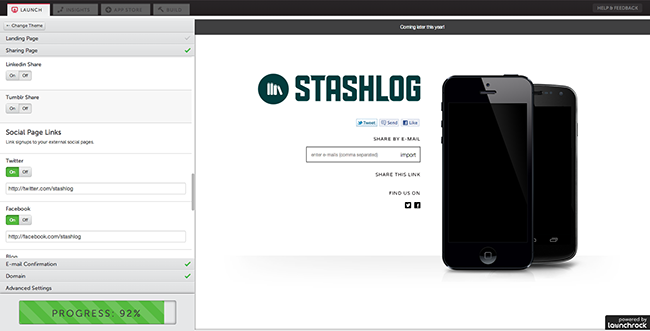
After that, you can configure the email that is sent out when someone signs up - you generally just want to thank them for their interest, and perhaps encourage them to share the page with friends. You'll need to enter a physical address to have on record as part of the CanSpam compliance.
Almost there - now we need to decide what domain to set the page up on. You can fill in the subdomain here, and then need to go over to wherever your DNS for the domain is hosted to setup the rest. Most likely the DNS is hosted with the company you registered the domain with - Launchrock helpfully provides a link with instructions for a lot of the main registrars to help you with the DNS setup.

Lastly, you can choose whether your landing page will show up in the Launchrock directory, which may attract additional interest - that depends upon how you want to promote the site, as to whether that's a good fit for you. If you just want as many eyeballs on the page as possible, then it is probably a good idea! Then enter a few tags that relate to your idea to help search engines index the page.
You can also enter a Google Analytics ID to provide page analytics. We'll be looking at analytics in more depth in a later post.

The progress bar at the bottom will let you know if you've entered everything you need - if it's still under 100%, hover over it and it'll tell you what you missed (I forgot to upload the images used on the iPhone and Android devices on the landing page). Once you've done everything, it'll change to a big green "Launch site" button!
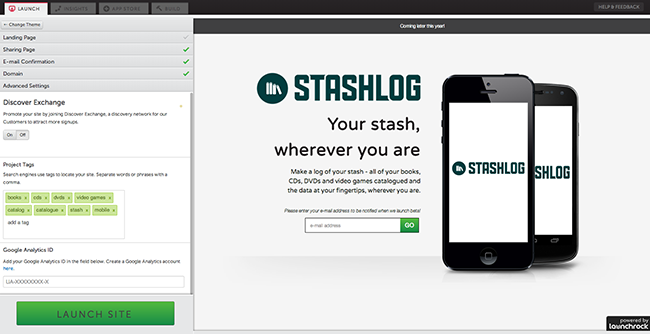
Go ahead and press it, and you should see a "Successfully launched!" message.

You can now go ahead and promote this - bear in mind that if you've just set the DNS up, it might take a while to propagate so that everyone sees your shiny new launch page, so it might be worth trying the URL yourself first, as well as sending it to a few friends to verify it's accessible.
All being well, when you visit your launch page URL, you'll see your landing page, ready to accept email addresses from interested users.
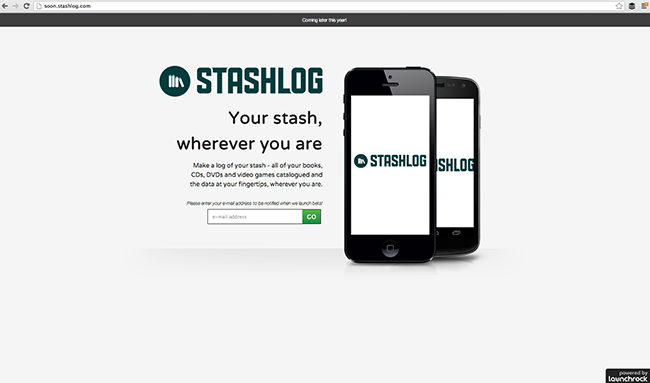
You can check out the actual landing page I just setup for Stashlog here - remember to signup if it is of interest to you!
Next time
So you have a launch page setup for your idea, or perhaps even multiple pages for different ideas. How do you determine if there is a lot of interest, or which page is performing best? Next time around we'll look at setting up analytics, and then analysing that data to make informed decisions and to take the next steps for your idea.
CommentsValidating business ideas May 29 2013
In our last post, we discussed how the business you always wanted to start might be right under your nose, waiting to be explored. It might be a passion or a hobby, or something you have a lot of experience with - but by finding the right way to monetise it, you could turn it into a source of income, and therefore freedom. Or it might be that your idea is more about making a change rather than making money - that's great! But you still need to ensure it's a valid idea, with a valid audience, in order to succeed.
So let's get to the nitty gritty - how do you know if your idea is a good one? What if you have several ideas, and you have no idea how to decide which one is the best one to progress with? Well there are a few different tools at your disposal to find out audience and market data that can help inform your decisions, and we're going to run through those now.
Tools
The first step is the simplest - Google for your idea. You might have a few ways that you can search for your idea in mind - the best thing is to try to put yourself in the shoes of someone trying to find you. What are the kinds of things they might search for? Make a list and try them all, and keep an eye on what the top results are, how many results there are, and whether any of the results are that similar to what you had in mind. Bear in mind that as you are validating the market, and therefore your idea, you should actually hope to find some competitors. If it's something incredibly revolutionary then there may not yet be an existing market for it, but for everything else it's unlikely you'll be without competitors - unless it's not a particularly good idea. Other people with a similar idea or in the same market as you serves two purposes. For one, it proves that it is a good idea, or at least good enough to get to the point that someone else thinks it is valid too. And secondly, it allows you to gauge your own site copy, information, and even price points with a direct comparison to a competitor, which will help you to make your idea the most attractive and competitive it can be.
Once that's done, and you are happy that there are some people that would be receptive to your idea, then the next thing is to quantify that market a little. You can do this using the Google Keyword Tool. This tool lets you specify a search phrase or word, and will let you know how many people approximately are searching for that term each month (globally, and within specific locations), as well as providing the stats for a whole bunch of related keywords and search terms too. You can compare the figures amongst keywords and search phrases, to see what seems more important to people.
The next tool for establishing the reach of the target audience is to use Facebook adverts. You can go through the process of creating a Facebook ad without actually posting it, and doing so will let you narrow the target market using various different filters (such as gender, age, and other pages liked) in order to find the total reach for your advert. This isn't an exact science, but given the vast amount of people that have Facebook accounts these days, and the fact that you can narrow things to just your target market, it provides a valuable tool in establishing the rough market reach for an idea, and as a way to compare multiple ideas against each other it is pretty useful.
Putting it into practice
Let's put this to use with a concrete example though, so we can see how these tools work in practice. Our great idea that we want to validate is an iOS app that will let you track the number of cups of coffee you've had in a day. Incredible right?
First off, we'll start with some Google searches:
As we can see, there are a few competitors in this space, and specifically there is already an iOS app. This is good in as much as we're not the only ones to think of this idea! But the downside is that we'll have to bring something else to the table to be a worthwhile alternative to this existing app. For now though, is the target market big enough to make the app worthwhile?
Here we can see the keyword breakdown for our search terms - as we might expect, the other keywords are dominated by things that people search for a lot more - coffee, coffee shops, and coffee beans. There is a fair amount of people searching for "coffee counter", but still perhaps not as big a market as we would have liked - or perhaps it's simply already exhausted with the existing competitors.
However, let's take a look at the Facebook research to see what the potential market reach would be there:
You can see most of the main filter options there, alongside the very easy to use audience number on the right that will change as you alter the advert parameters. We have a potential audience of almost 16.7m people that like coffee in the UK and USA, between the ages of 20 to 40, so maybe this app isn't such a bad idea after all!
In all seriousness, the Facebook reach needs to be taken with a pinch of salt, and you shouldn't be basing your actual business plans or revenue models on this data - it's mainly useful for comparison purposes, and for smaller niches.
The value of a niche
One other thing to bear in mind is that sometimes you might have a product or idea that is very specific but valuable to a niche, and therefore would have much smaller figures using these tools. If you had an idea to sell a $0.99 app to a potential audience of 16.7m people, and a $10K training course to 20K people, then you'd make more money (assuming you were able to completely saturate both markets, and ignoring overheads) from the training course! The point is that these tools will work best when comparing ideas within a similar scope - perhaps when comparing the different types of training you might offer, or if you wanted to write a book for a specific field but wanted to narrow down the most interesting and sought after topic.
Next time
So now you have some tools for comparison - simply running through your list of ideas should let you prioritise to bring the ideas with the best potential to the fore. The next step is to setup a landing page for the idea (or for all of the remaining ideas, if you are still whittling them down), to gauge interest for an idea or concept by asking them to register for more information, or even pre-order if applicable for your product. We'll work through how to set this up in next weeks post.
CommentsElliott has contributed to repositories in 9 different languages. In particular, Elliott is a serious Ruby expert with a surprisingly broad knowledge of JavaScript as well. May 25 2013
Fantastic site called “The Open Source Report Card” which takes a look at your public GitHub timeline and gives you a rundown of your skills based on project contribution, as well as when you are most active and productive. Very clever stuff, and makes for some rather ego-inflating snippets that you could post on your blog, if you were so inclined.
CommentsBusiness? What business? May 24 2013
If you have browsed around our new site, and you don't happen to own or run a business right now, you might have wondered - "why do they keep going on about my business? What business?". The simple truth though is that most people have dreams of running some kind of venture, whether it's something they want to do for the experience, or for financial reward, and whether it's something that's a passion, or simply an opportunity. Almost everyone I speak to talks about "one day starting my own thing". Why not make that day today?
Even if you have a full-time day job, there is no reason that you can't start in on your dreams now. Evaluate your options, validate your ideas and concepts, prototype them in your spare time, and talk to people about your idea to get a feel for how it'd be received. Start small, but make sure you start. The more you work on your idea, the more you talk about it and share details about it, the more real it becomes - until one day, maybe it can pay the bills!
It's true that here at KickCode we want to get across how focused we are on helping businesses be the best they can be, bringing our expertise to the table in order to help achieve goals such as increasing revenue. But "business" is quite a far reaching term - and it extends from a single person with a great idea, to startups, to established companies and corporations looking to improve or expand in a specific area.
So, if you're asking yourself "business? what business?", remember that your ideal hobby, activity or craft might actually be a great business idea - make sure to explore it!
In a future post we'll talk more about how you can quickly validate business ideas using online tools, or to whittle down your ideas and pick the best one if you have a few of them! To make sure you don't miss that post, or any other future posts, subscribe to our newsletter.
Comments"Success isn’t about working hard, it’s about working smart" Apr 4 2013
http://pandodaily.com/2013/04/03/you-dont-have-to-make-yourself-miserable-to-build-a-great-company/
Interesting article by Andrew Wilkinson, the founder of MetaLab, giving an oft-overlooked and differing viewpoint to the usual “work around the clock to build your startup” rhetoric. I still think to be successful takes hard work as well, but being efficient and doing more in less time to make that happen sounds like a win.
Commentskickcraft Mar 19 2013
I finally got chance to mess around with voxel.js the other night, and thought I’d have a little fun with it. You can do an awful lot of cool stuff with voxel.js and its associated modules, including generating terrain from a PNG heightmap. But I thought it might be cool to create structures from a PNG, so you can automatically have structures built and hoisted in front of you in the 3D world, based solely on a 2D graphic. Thus, kickcraft was born.
It works best with logos, where there is only a few colours in play and fairly distinct, simple shapes. It uses the incredibly useful png2json script from within the heightmap terrain module to turn a PNG image into a JSON document. From there, kickcraft loads it in, and looks up materials for the colours it finds in the RGB data for the PNG. There is a hosted demo here which loads the KickCode boot icon by default, but you can also click here to see it running with the image data for the full KickCode logo (you’ll need to keep walking to see the entire thing, as the draw distance comes into play). You’ll need to be using a browser that plays nicely with WebGL too.
I could do a lot of cool stuff to extend it - color shading/tinting the basic materials to match the source color would be a particularly nice first step forward, so then it could automatically deal with the entire RGB range, rather than as it does currently, matching specific colours to the materials to use. Then a hosted PNG to JSON converter would mean you could point it an image URL, and have it show up in the world!
In time it might well then work as a sort of mosaic structure builder for even more complex images, but for right now it was a fun little experiment to create a 3D world with a little something of mine in there. If you’re interested in getting started with WebGL then voxel.js is a great, fun way to dive in.
CommentsGetting started with Ruby 2.0 and Rails 4.0.0 beta 1 Feb 26 2013
It’s an exciting time to be a Rubyist as we get lots of new versions of things to play with. Ruby 2.0 is finally out, and with it a raft of updates across the board for various Ruby related software, including the first beta of Rails 4!
To get up and running quickly with Ruby 2 and Rails 4 (using RVM), it’s pretty easy:
rvm get stable
rvm install 2.0.0-p0
rvm use 2.0.0-p0
rvm gemset use rails4 --create
gem install bundler
gem install rails --preIf that last command doesn’t work, try:
gem install rails -v 4.0.0.beta1And then when the gems are installed, you can create a new app using Rails 4 beta 1:
rails new new_rails4_appIf you have SSL cert issues with Bundler under Ruby 2.0 (it’ll error on the Rails app creation as it runs bundle install by default), then you might find that the following helps:
brew install openssl
rvm get head
rvm reinstall 2.0.0-p0The latest RVM builds against packages found in Homebrew by default, so it’ll use the Homebrew OpenSSL. You’ll then most likely need something like these commands to sync the Homebrew OpenSSL CA certs with the system keychain, or indeed this tool will add a crontab entry that regularly keeps those certs in sync, useful if any certs change in future.
The other alternative is to skip bundling when creating the Rails app:
rails new new_rails4_app --skip-bundleAnd then switch from HTTPS to HTTP in the Gemfile for the newly created app, although I wouldn’t recommend it and it’d be better if you can use the above instructions to get it working over SSL.
Once that’s all installed, you can get to grips with the latest changes in Ruby 2.0 and Rails 4.0.0, so have at it! I’ll be posting more about the features these new versions introduce shortly, so follow me on Twitter!
CommentsPlayStation More Feb 20 2013
I’ve not been too excited about the Sony PlayStation recently. The vast majority of big game releases are multi-platform, and most of them end up having better DLC support on Xbox 360, as well as the online aspect being a lot better on Xbox Live. In fact, since moving house six months ago, I haven’t even unpacked my PS3 and set it up. I did trade-in my PS Vita though and pick up a second Xbox 360 for the office (for lunchtime guitar learnings on Rocksmith, and not lunchtime online sessions of Halo 4, of course).
I am still excited about the PlayStation announcement shortly though. It seems pretty nailed-on that this is the PS4 unveil (look for Sony’s stock on the floor of Wall Street tomorrow if they don’t unveil a next-gen console), but obviously the specs, the look of it, the tech and features, and most importantly the launch games are all up in the air. I don’t imagine we’ll get a firm release date or price today, although it’d be nice if they were looking at a worldwide launch rather than EU being months behind like with the PS3, and if the UK price wasn’t just the US price with $ changed to £.
The games will most likely be a mix of franchise favourites, I expect an Uncharted, Gran Turismo, Final Fantasy, and maybe even an exclusive Metal Gear Solid perhaps. Unlikely that any of these will show off too much or even give final titles (Uncharted 4? Gran Turismo 6? Final Fantasy 54?). But it’ll get the Sony exclusive buzz back which they so desperately need.
The specs and look of the console will probably turn out to be fairly uninteresting. Specs wise I think the next-gen will be a lot more even, with both Sony and Microsoft looking to use more off-the-shelf components so that the launch price is cheaper and more affordable, and they can start to profit on each unit much quicker (traditionally very difficult at the beginning of a new console cycle). The looks won’t be as outrageous as some suggest I don’t think - people won’t be making any console the centerpiece of their living rooms, and I think these companies know that now. Instead look for something that fits in nicely amongst other AV components, but with a traditional Sony fit and finish that suggests quality.
The most interesting aspect by far is features. The PS3 lagged behind the Xbox 360 in terms of the online service and offerings by a mile, only recently starting to make inroads with PlayStation Plus. An extension of this, with the Gaikai acquisition finally being put to use as a PlayStation branded game streaming service so that you can play PS3 games on the PS4, would be pretty compelling. Still will be interesting to see how they’ll let people turn their physical PS3 game collections into games they can stream on PS4, but it’d lay down the gauntlet for MS and the next-gen Xbox.
If they could also get the hang of reasonably and competitively priced day one download releases for their flagship games, they might even have a true 21st century offering on their hands… and about time too. One thing is for sure though, it’s make or break time for PlayStation with this next-generation now, and I fully expect that Sony will have either entirely missed the point with PS4, or will have absolutely nailed it. We’ll hopefully find out tonight.
CommentsGaming an A Feb 17 2013
Some more real life game theory application as a group of college students exposed a loophole in the scoring for their class. When told that the top score on their exam would get an A, with everyone else graded on a curve adjusted behind the highest score, they decided unanimously to boycott the exam. By all getting the joint top score of 0, they were each awarded an A!
More details over on the NYT Economix blog, but it just shows how knowing a bit of basic game theory and being logical can pay off!
CommentsGame theory in the wild Feb 6 2013
This is an interesting blog post, taking a look at an application of game theory in relation to a problem generally referred to as a “prisoner’s dilemma”, but this time it’s playing out on a television game show.
Pretty clever stuff, but one thought I had is that while the strategy is pretty cunning, it does rely somewhat on not encountering a destructive opposition force. Specifically, what if you were playing someone who didn’t trust you, and had the mentality “if I can’t have it, no one can”? They would choose to steal the money, knowing that if you followed through on your ultimatum, neither of you would win, and that if you were bluffing, they would win the lot.
The theory here is ballsy, and sides with the odds (and basic, compassionate, trusting human nature) - but isn’t without its own risks, given that in a case like this, you don’t really know the person you are playing against.
A more recent and in depth look at the logic behind the “prisoner’s dilemma” is here, and goes into a nice level of detail (along with links to some web based simulators) on the best strategies when playing the game. It too includes a link to a clip from the same game show, albeit a different clip, with a rather surprising result.
CommentsPage 5 of 31 | Next page | Previous page
